
Grouping is an essential component to Math Workshop success in your classroom. After your warm up and mini lesson are over, students will rotate through M.A.T.H. practice activities each day. If you are not familiar with the Math Workshop framework, please read this post first.
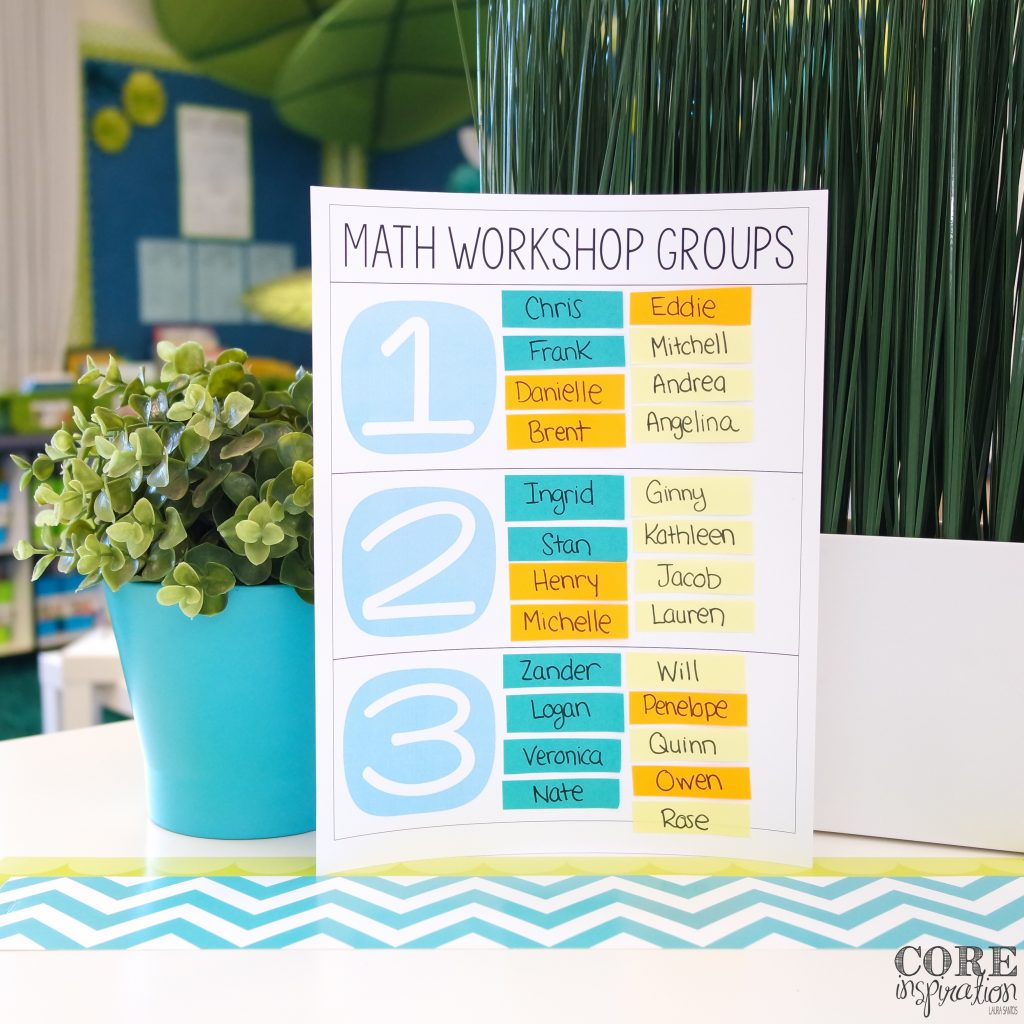
So, how do you group your students to ensure efficiency and success for all? A quick pre assessment is worthwhile in helping you design differentiated groups, and will make your daily M.A.T.H. rotations more efficient. Once you’ve got your pre assessment results handy, use the guidelines below to help you establish your groups for the unit, quarter, or trimester.
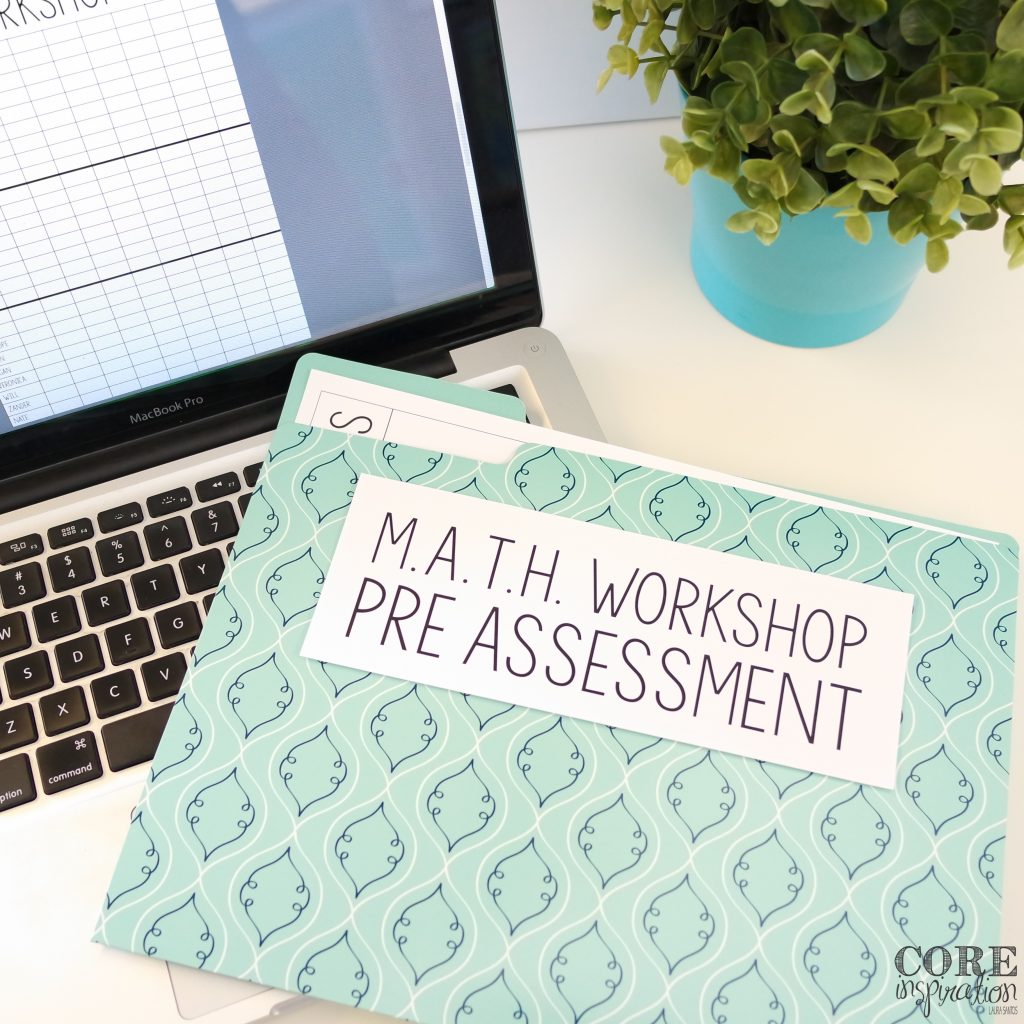
This grouping approach comes in handy when your assessment results show student understanding of the skill(s) being introduced is scattered. To group by skill level, begin by determining the number of groups you will have.
Three groups is appropriate if you plan to have a flexible “Meet With The Teacher” schedule. This approach allows you to call students to the small group area based on your observations of student needs during workshop on some days, and have a set group meeting schedule on other days.
I recommend the three-group/flexible schedule approach. This allows you the flexibility to meet with each group weekly, while leaving room in the schedule for meeting unforeseen student needs without disrupting the flow of student rotations.
Here’s a peek at what your schedule might look like if you have three skill levels groups:
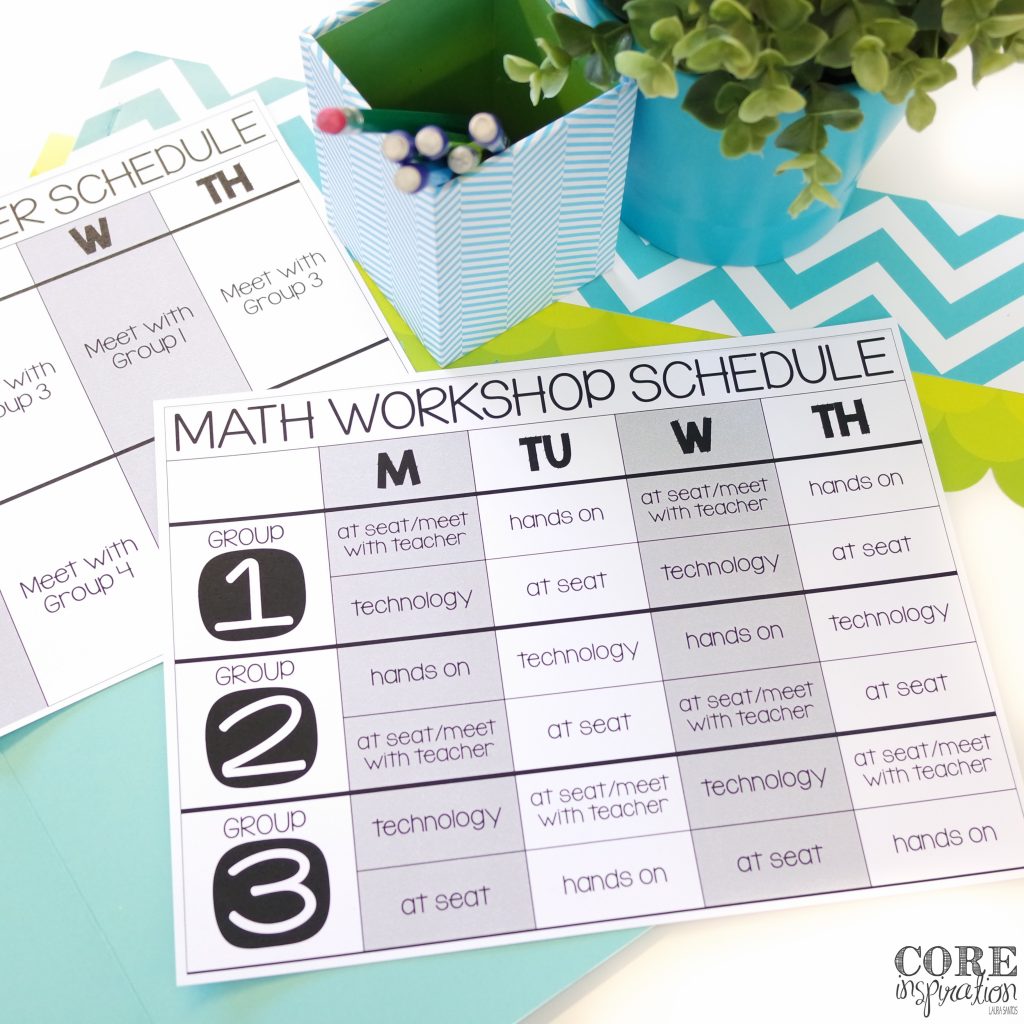
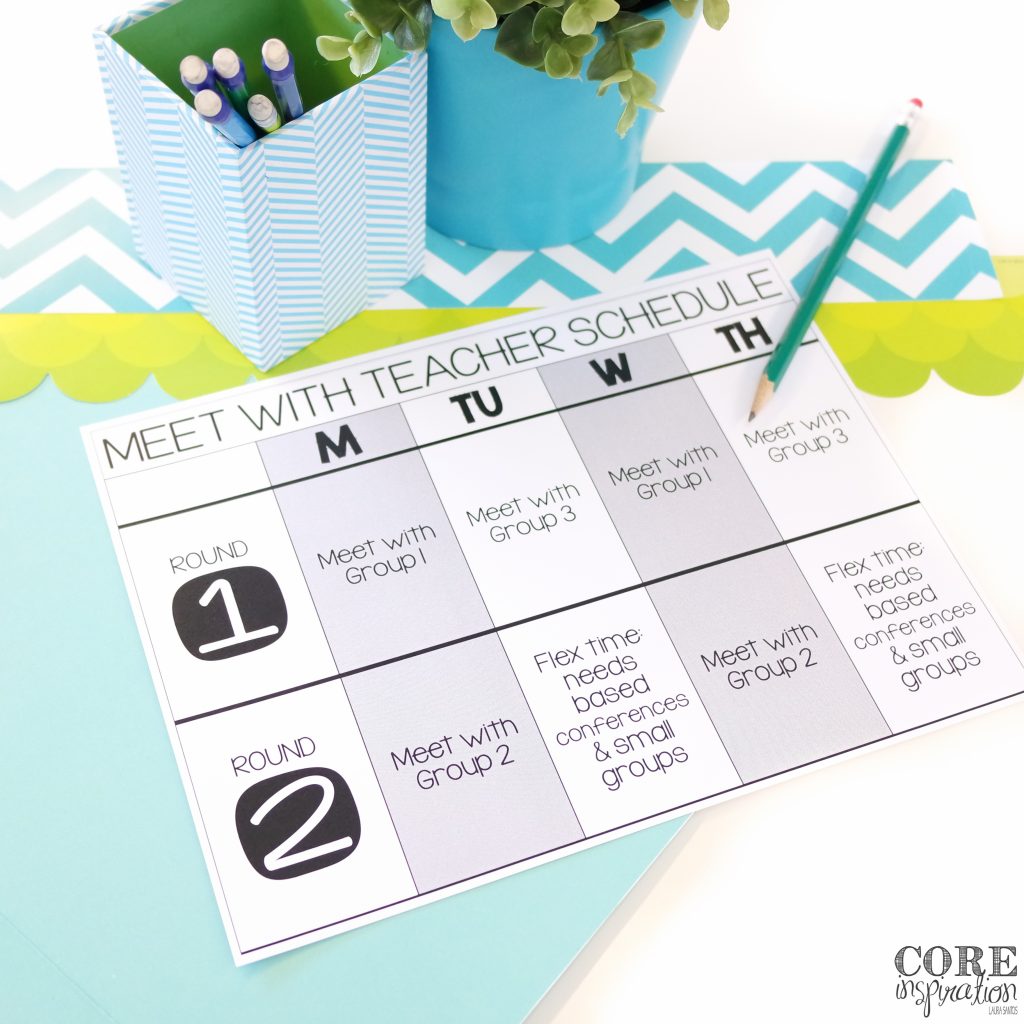
Four groups is appropriate if you plan to have a set “Meet With The Teacher” schedule. This approach allows you to pre-plan your small group instruction needs and have a set course each day. Unfortunately, if you have a schedule conflict, the group you are set to meet with that day misses out on their “Meet With The Teacher” time, and there is no flexible room to make it up.
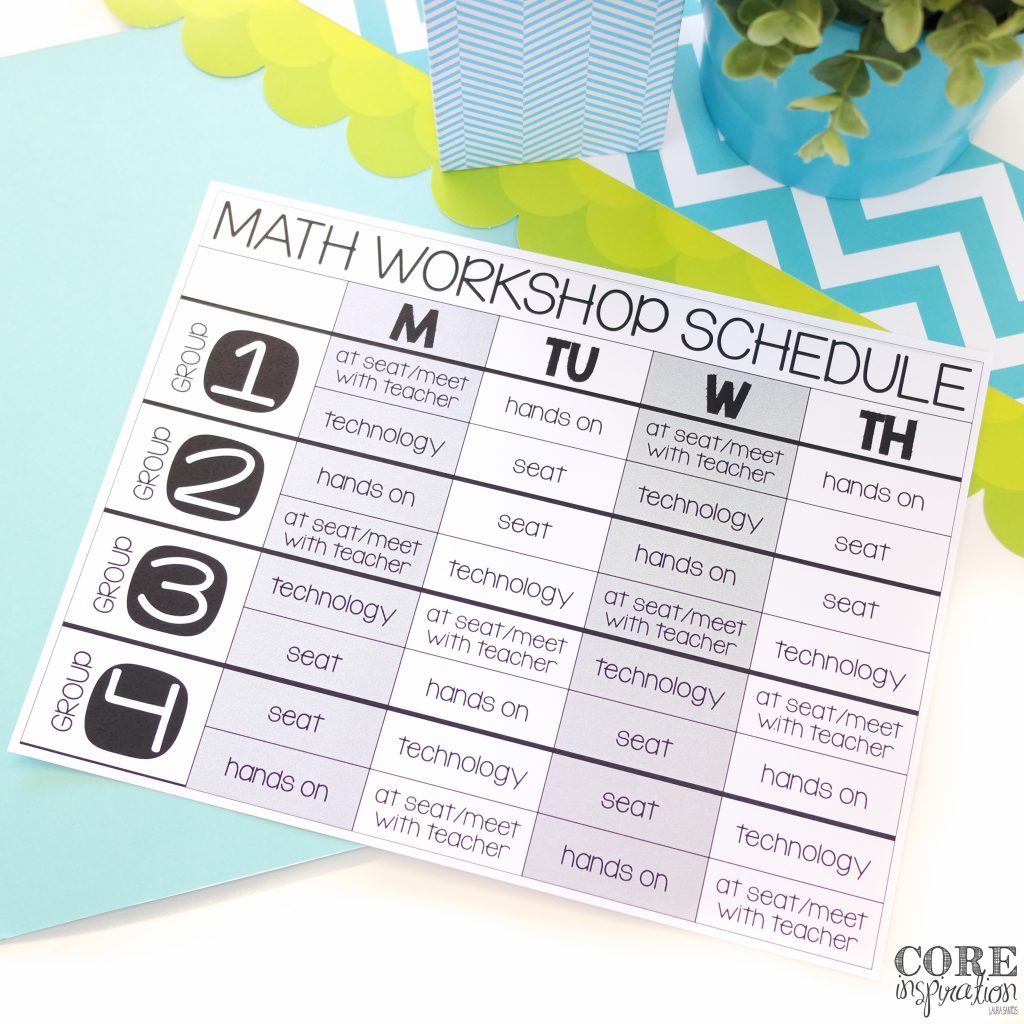
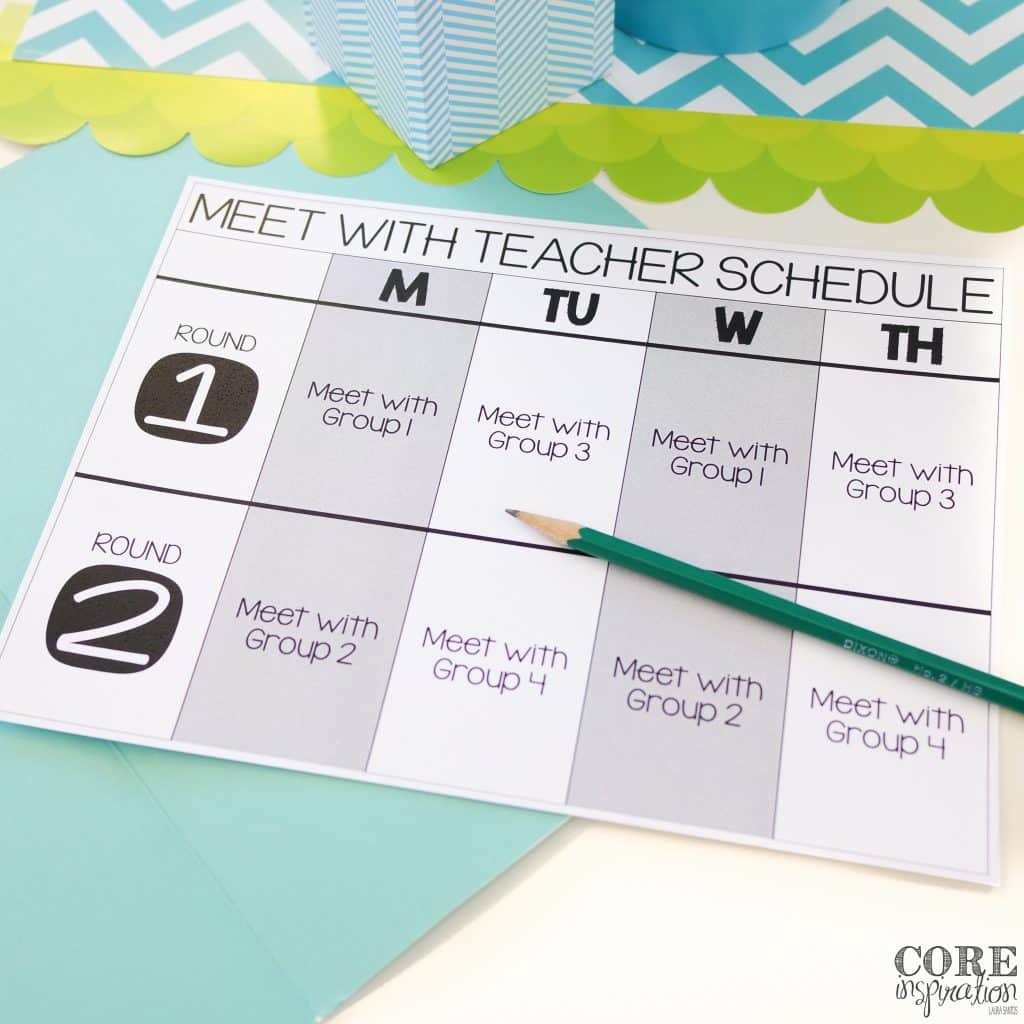
Arrange your students into these groups based on their level of understanding while trying your best to maintain a fairly balanced number of students in each group. This is where group creation becomes an art, not a science. If your groups are unbalanced, move beyond looked solely at the assessment data, and begin to consider student work habits. Factoring in how quickly students catch on to new concepts also helps to create balance.
This grouping approach comes in handy when your assessment results show the majority of your students have the same level of understanding for the skill(s) being introduced.
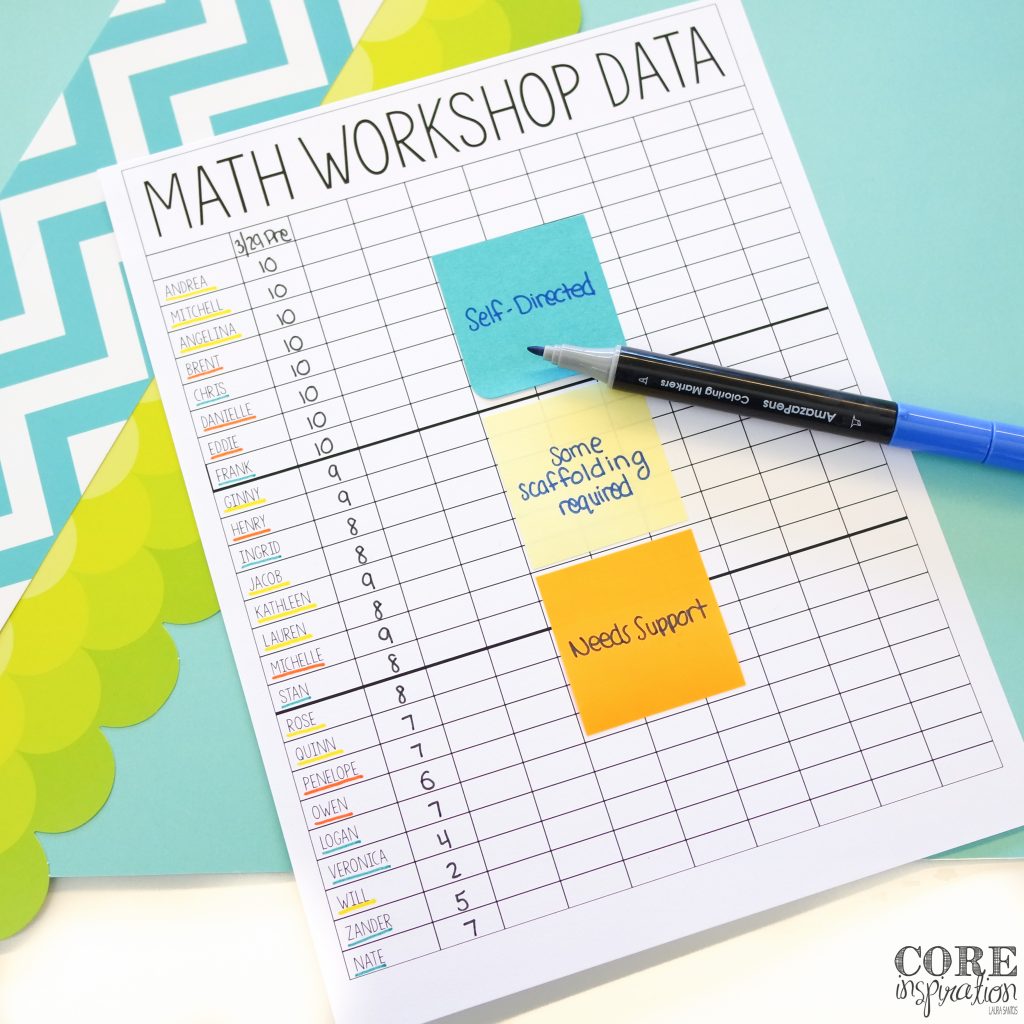
When grouping by work habits, create heterogeneous groups that include a balance of students with strong self-direction skills, and students who require additional guidance and support. This is a wonderful opportunity for students to learn from peer role models who can foster stronger work habits in those who are still developing these essential skills.
When utilizing the work habits grouping approach, you will likely find you’ll spend less time in your small group work space, and more time around the room having one on one conferences, and pulling groups on an as-needed basis.
Regardless of the grouping approach you use, establishing Math Triads in your classroom will further foster student independence and resourcefulness.
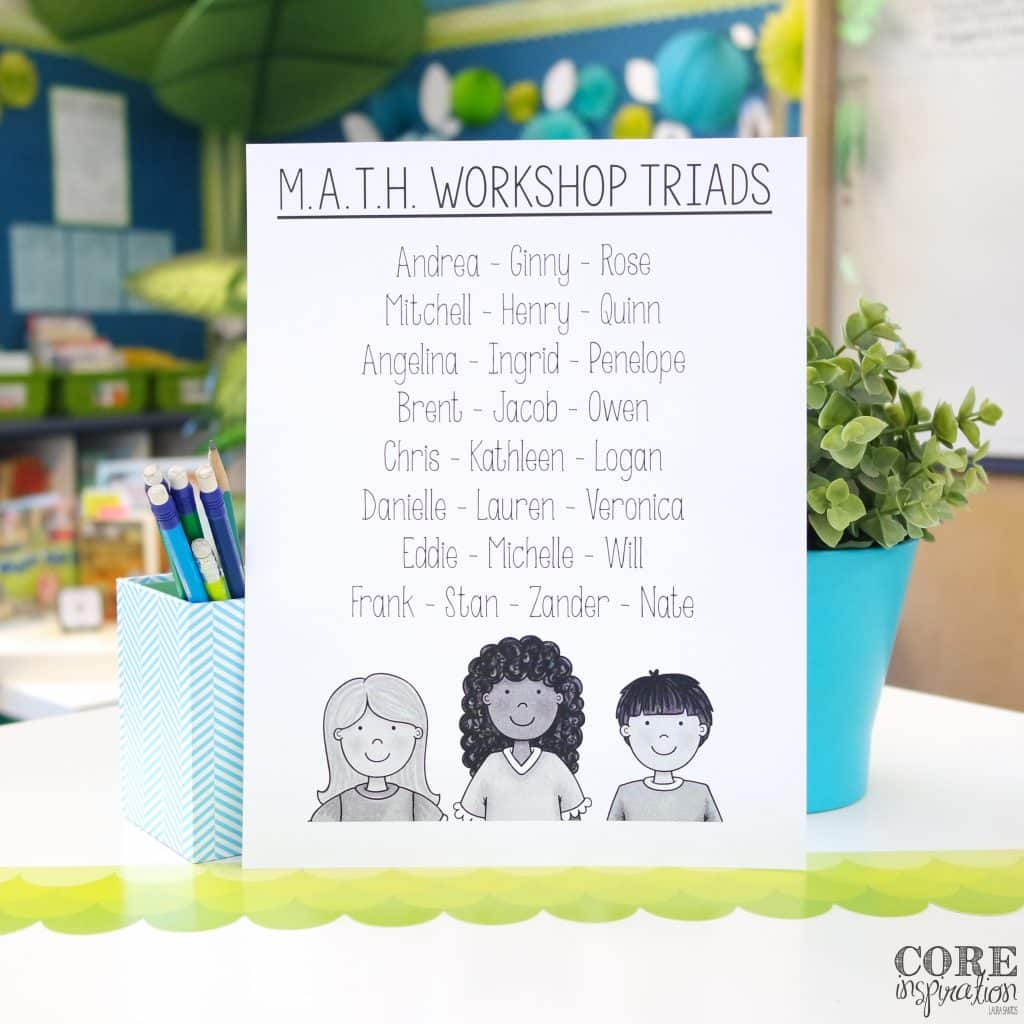 A Math Triad is a strategically designed group of 3 students who check in with one another during workshop each day. Here are a few roles of a Math Triad:
A Math Triad is a strategically designed group of 3 students who check in with one another during workshop each day. Here are a few roles of a Math Triad:
When creating Math Triads, avoid grouping your mastery-level students with students who need the most support. Instead, use your pre assessment data to arrange students in order from highest to lowest score. Divide this list in thirds and pull one student from each third to create your triads, as shown below.
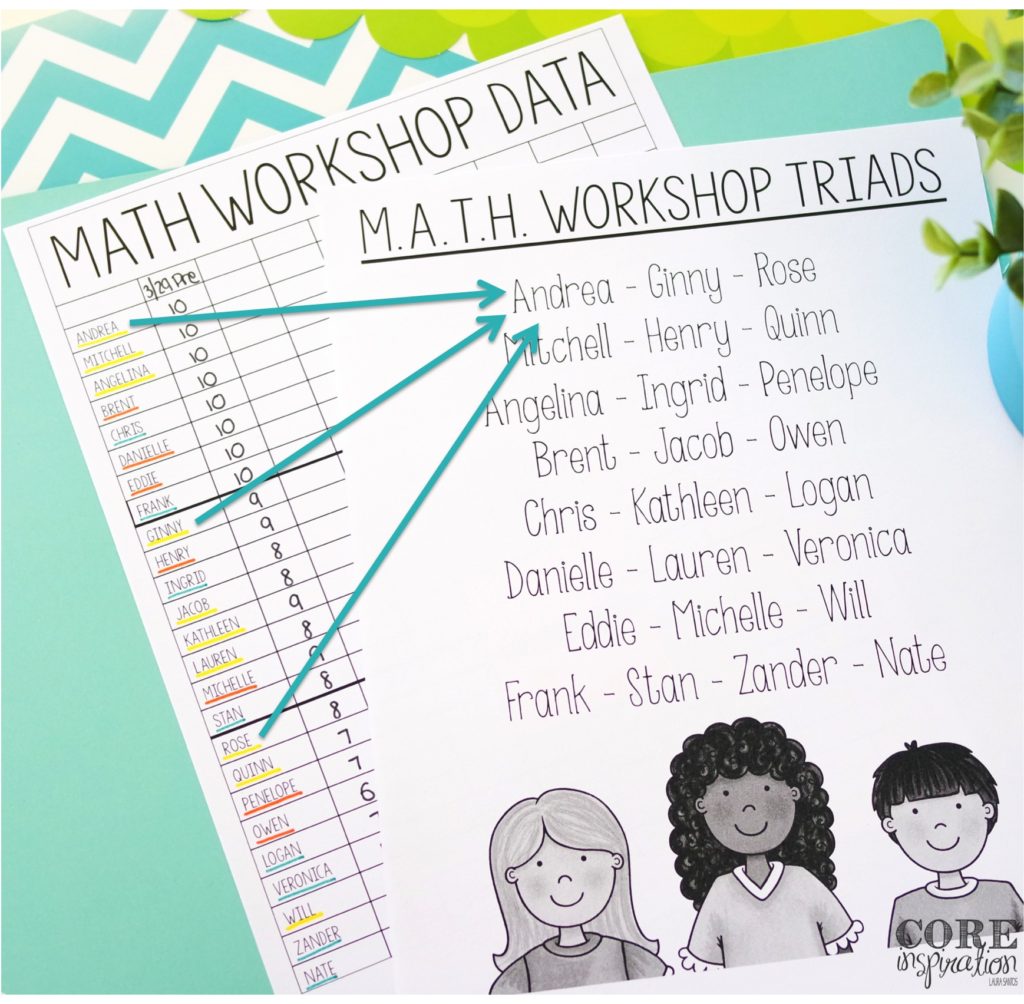
For more details about Math Workshop, check out my other posts about this instructional approach.
If you want to give Math Workshop a test drive in your own classroom, grab your Math Workshop Starter Kit, and feel free to share any questions you have about implementation in the comments below.


I’ve been an elementary teacher for ten years, and love sharing tips and resources that make differentiated learning more manageable for you. Thank you for visiting.
Learn More
Dropping by with weekly tips, classroom strategies, and free content created with you in mind.
Join me and other 2nd through 4th grade educators in the Teaching with Core Inspiration Facebook Group. This is a place to collaborate, ask questions, and learn how teachers like you are using Core Inspiration resources in their classrooms. Hope to see you there!
© 2024 Core Inspiration ∙ Website by KristenDoyle.co
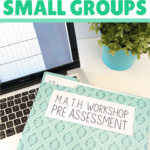
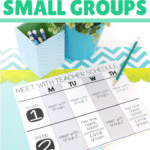
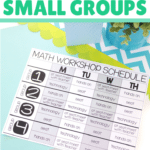
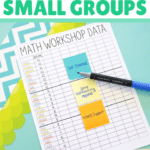
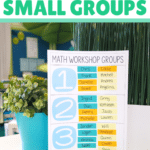
56 Responses
Hi Laura,
What template do you use for the 3 groups and the students in each group? The picture at the top? It’s a great visual!
Thanks!
Hi Lauren, That template is just a printable I have to help with the random grouping needs. I am happy to send it your way if you send me an email. 🙂
I would love to get that from you… Thank you so much! My email is [email protected]
Thank you again!
Great post, but just a question… What do your Fridays look like? Also, do you have any suggestions for replacing the “technology” time? Unfortunately, my classroom does not have any classroom computers or iPads…
I is was wondering the same thing. Maybe PBL? Or math games?
Hi Melissa, if you’re look for other options to replace the technology rotation or if technology isn’t available as a consistent rotation, I recommend adding in “Time for Facts” and using a math facts fluency toolkit. You can also make it “Time for Projects”. Hope this is helpful as you plan workshop in your classroom. 🙂
I would love a template of the teacher schedule for the math workshop for 4 group option.
Hi Jennifer, you can find them here.
When you have the 3 group schedule, you have each group scheduled for two rotations (meet with teacher and technology for example) I’m interpreting that as those students will meet with the teacher during their first rotation. During the second rotation (when the teacher is meeting with the next group), they go to the technology center. When you meet with your third group, what are the students doing?
Hi Lauren, you are correct. I don’t meet with all three groups every day… my schedule doesn’t allow for that. If I did have a schedule that allowed me to meet with all three groups every day, each group would have the opportunity for more game time or tech time.
Thanks!
Hi Laura, I would also love the get the template you use for the 3 groups and the students in each group. If you are able to, could you email it to me as well? I just stumbled on this treasure trove of yours tonight and am so excited to try all of this out next year. Your classroom is so visually dreamy and calming. Lovely! Thanks so much.
[email protected]
This is all wonderful! I would love to now what you do on Fridays. My other question is how long is each rotation? Two rounds… at 20 minutes each? Thanks!
Thank you Kim. This year on Fridays, we had P.E. in the middle of our math block, so I did four days of workshop. On Fridays, I did a longer morning meeting, the students went out to P.E. and then completed their word work when they returned. This changes from year to year based on our school specials schedule. You are correct on the length on the rounds…two rounds for twenty minutes each.
Hi Laura! If I’m understanding correctly, you have around 8 students per group if split by skill level when doing the three group schedule? I’d like to implement the same schedule but would like to know how you manage so many students in your small group while still meeting the 20 minute time limit. Do you have each student complete the same problem, teach/discuss the problem, and then fill out the feedback form? Trying to work more on time management in small groups this year and I believe this could be the way to go!
Hi,
So I read the six posts about the “Math Workshop” I Love it. Is there a way you can create a video showing how it works in your classroom if it’s not to much? Also, if you don’t mind can…. at times I run into the problems of purchasing products with clip arts of kids of that don’t really show different diversities, can you include some diverse clip art in your M.A.T.H workshop bundle ? I’m definitely considering purchasing your math workshop bundle. I’m hoping that I can follow it with ease.
Also what math pre assessments do you use? Also, I typically have students who have difficulties in reading. However, their math computation is well. How would you group them? Without someone reading the problems to them, they aren’t as successful compared to basic computation problems.
Also, I noticed that your groups are 8 students per group. I typicaly have a class of 20 max 22. Are you doing small group “Meet the Teacher” will all 8 students at the same time and if so, is this at a table? If not are you splitting up your group of 8 students?
I notice that you track data weekly with some type of activity to demonstrate understanding. How often do you change the workshop sessions? I know that you keep the activities for a month. For example, Once I have my data on who didn’t do so great on a certain standard/skill do I switch their groups or keep them. I wonder if you keep them since you mentioned just giving them a “take home assignment” & or “verbal conversation to justify their work or understanding”
I guess I’m trying to figure out my next steps for my next workshop the next day. If I’m correct the verbal comments, take home activity, and curated activities should be just fine vs. rearranging my groups daily. That would be quite tedious!
Also, what’s in the green bins, and the “Our Drop Box”? How do you implement the Our Drop Box and also unfinished work during the Math Workshop “At Your Seat”?
May I also have an email of your freebie of your Problem Solving Process.
My apologies for so many questions.
Hi Brittany. Although I agree that a video would be helpful, making one showing math workshop in my classroom isn’t in the cards for me. The time when my students are in the classroom, my focus need to be 100% on their needs, and don’t feel comfortable filming them.
As for the math workshop bundle with diverse representation, there are only two items in the bundle that feature images of children and they are not color/filled images…only black line format.
When it comes to pre assessments, I use a combination of the the assessments provided by EnVision CA (our math adoption), and sometimes pick a quick Transfer task from my Problem Solving Task Card collections. If students struggle with reading, I read the math test for them as I am only trying to assess their math understanding, not their reading ability during this time of day. I group them only according to their math ability, not their reading ability.
When it comes to meeting with students during “Meet the Teacher”, I will either pull a group to the back table, or move around the room for one on one conferences….this changes from day to day depending on the needs I see in my students during the mini lesson. Once I set up groups for a unit, I keep them group that way until the end of the unit to be efficient. Changing from day to day is too complex and time consuming for me.
The green bins are where students submit their task card recording sheets – the are called “rubric bins” so that students can assess their own work when they turn it in. The drop boxes are for homework collection…I just store them near our math supplies because that’s where I have room. 🙂
You will get a free copy of the Problem Solving Process when you subscribe to the blog.
Hi Laura,
I’m so glad I stumbled upon your blog! I’m excited to try out this approach this year. I’m hoping it will help me have success with blended learning in my classroom!
I have a question about the math triads. If the math triads consist of a person from each of the three groups, and they are all working on different rotations, how do you manage how and when they check in with each other?
Thanks so much!
Alexis Burke
Hi Alexis,
So exciting to hear about your enthusiasm for this approach. 🙂 Very often the members of the math triad are working on different activities. During our “training” and interactive modeling on how to be a productive triad member, we talk about how to politely ask for help when someone is focused on something. The kids are always so excited to help one another that they never seem to mind pausing their game, project, or technology session to answer the question a peer has. It’s a pretty flexible set up. 🙂
Have fun starting M.A.T.H. Workshop in your classroom this year.
Warmly,
Laura
Hi Laura, I found your blog through TPT and am absolutely loving it! Thinking about using this model and purchasing your bundle in the TPT store, but what I’m still having trouble understanding is that if you are covering a new lesson each day, but only meeting with two groups each day, doesn’t that mean two groups aren’t getting access to the teacher (and an in depth lesson) each day? There’s so much content I feel that I personally need to teach each day that a 5 to 10 mini lesson whole group doesn’t seem like enough to deliver all content to all students without meeting with each small group each day. Thoughts?
Hi Brooke,
Thank you for reaching out. Every student has access to the teacher each day through the mini lesson. When teaching the mini lesson, I cut down to the core concepts that need to be taught that day and “teach to the middle” during the mini lesson so everyone is exposed to the standards and content equitably. When I pull groups, have one-on-one conferences, and when students are working on their rotation activities, they are practicing that content at their level and getting personalized learning support. This is why I tend to prefer having a flexible Meet With Teacher schedule rather than a set schedule – it allows me to touch base with students based on the needs I see during the lesson each day. This is where the check-in sheet comes in handy because I can make note who I’be met with from day to day to further ensure equity, keeping in mind that equity isn’t always about the amount of time given to a student, but more about providing the student what he/she needs to make further growth – this looks different for everyone.
Using the workshop approach is definitely a mindset shift. Although the district adopted curriculum is extremely helpful with pacing, it provides far more busy work than I am willing to have my students spend time on. I have to dig down to the core concepts that are most connected to the standards and prioritize that content.
I hope this provides some insight as you make decisions about your instructional approach this school year.
Warmly,
Laura Santos
Hello! I love this M.A.T.H. workshop idea. I am going to be starting math small groups this year and really want to use your ideas. I am wondering what it is that you do on Fridays?
Hi Breanna, last year on Fridays we had two specials during our math block, preventing us from doing math on Fridays. Therefore, we only did number of the day in the morning.
Dumb question!
I purchased your MATH workshop kit. I love it have started introducing it but I must have messed up.
What happens if students from they MATH trio are in meet the teacher ? I must have planned wrong but it has happened several times. Has this happened to you? Did i make a mistake in planning? Thanks so much!
Not a dumb question at all. That’s one of the reasons I use triads instead of partners – sometimes one of the people is occupied at the meet the teacher rotation. In this case, the other members of the triad still have someone to collaborate with. I always try to make sure the members of the triad are in different groups if possible. 🙂 I hope this is helpful.
Warmly,
Laura
Hello!
Love these ideas, but can you explain something about the triads: if you group them by mixed ability levels with their goal being to be each others’ go-to people, how does it work when they will almost definitely be in separate workshop groups and thus working on different tasks than each other? I’m envisioning one partner needing assistance, say, on a practice problem, but one of his triad partners is in a strategy lesson and the other is on a technology task. If they’re always on separate rotation items, how are they able to work with and support each other? I’ve done problem-solving triads before, but they don’t carry over into the independent workshop rotations. TIA!
Hi Lindsay,
Despite the fact that students within a triad are often working on different activities when one needs assistance, they are always willing to help one another. They are so excited to be little teachers that they don’t ever seem to mind when their game or technology rotation is briefly interrupted to offer advice. The help session is always only momentary because we do a lot of modeling on how to respond to someone’s question with another question that will guide them in the right direction. If a triad member is working in small group, students know not to interrupt that activity. This is when the sign up for teacher help sometimes comes in handy. I hope this clarifies. 🙂
Warmly,
Laura
I am just beginning to implement M.A.T.H. Workshop in my room this year. I was wondering…do your Triads change with each unit of study?
They usually change each trimester for the first two trimesters, and then each unit during the last trimester. This is because T1 is focused on place value, adding/subtracting and for the most part students’ prior knowledge on these topics doesn’t vary much within those subtopics (i.e. a student who scores high on a place value pretest often scores high on a rounding pre-test or multi-digit addition pretest). The same is true for T2 when studying multiplication and division. The last trimester there is much more variety in prior knowledge for the units so triads change more frequently.
Warmly,
Laura
I purchased your math workshops starter kit. Is there a page to print for the meet the teacher schedule that is pictured above? I would like to be able to have that while I do my groups to stay on track. Thank you!
Hi Kristina,
Thank you for reaching out. In order to make the meet the teacher schedule, I retitled the editable M.A.T.H. Workshop Schedule document and added/removed a row as needed. I hope this is helpful as you create your schedule.
Warmly,
Laura
I’m wondering how you introduce math workshop at the beginning of the year. Do you start by introducing and practicing each section of the workshop (ex. Introduce and model at your seat, then introduce and model technology, etc or do you start the workshops and rotations as a whole from day 1? When do you teach and model how to play the activities and games for the hands on portion?
Thanks
Hi Erica,
Thank you for reaching out. I do introduce one portion of workshop at a time starting with At Your Seat, then Games, then Technology, and finally expectations for when I pull small groups for Meet with the Teacher. At the beginning of the year, I teach a couple games in the afternoons to get us started (separate from workshop time) so we are familiar with a couple games when the hands on/games portion of workshop is introduced. After that, I introduce new games every couple weeks to the whole class outside of workshop time (for us this happens right before lunch on Mondays).
I hope this is helpful as you get up and running.
Warmly,
Laura
I was wondering what your schedule looked like using this approach? How long do you spend at each rotation? Do you do this every week? I would love to implement this I just don’t know how to get it incorporated.
Hi Krysten,
Thank you for reaching out. I spend an hour on math each day. After our ten minute mini lesson, the students participate in two twenty minute rotations per day, followed by a 10 minute share activity. We do math workshop four days per week.
Warmly,
Laura
I am so excited to try this approach! I would love to do the 3 group schedule, but I have 29 kiddos this year, and that means 10 students in each group. Have you had a large group before and stuck with the 3 groups? Thanks in advance!
Hi Cara,
Thank you for sharing your excitement! 🙂 The largest group I’ve had with this setup is 25, but I will still stick with it even if I had 35! 🙂
Warmly,
Laura
I am so happy I found you!!! I currently teach 4th grade math and find it extremely difficult to differentiate. Many teachers in my building use a direct instruction approach to math based on the curriculum my district purchased. I feel that this is not meeting the needs of all my students, especially my higher kiddos. I’m currently take my last class for my M.Ed. in Mathematics, and for my research project I plan to implement your M.A.T.H. workshop (giving you full credit, of course!). I’m very nervous and overwhelmed at the thought of completely reorganizing my room and teaching my students new routines, but all of your posts have allowed me to wrap my head around things. Thank you!!!! I purchased a kit of yours on Teachers Pay Teachers and plan to use it in the coming weeks. My biggest struggle is what to have kids do for task cards… about how many do your kids typically get through in a day? Do all students have access to the same task cards, with the option of a challenge? Also, how often do you incorporate project based learning?
Thanks again!!
Hi Kelly,
Thank you for reaching out with the kind message. Please know I am not the creator of Math Workshop, simply one of the many teachers who has found a variation of it that has been useful for me and my students. I am happy to hear you find the tips I’ve shared useful.:) My students complete 2-3 problem solving task cards per week because they require a great amount of detail and modeling. They all have access to the same task cards (I provide four making meaning tasks and four challenge tasks per week), but they make the decision about which tasks they want to complete. I incorporate one project based learning unit per trimester. Please let me know if you have any additional questions.
Warmly,
Laura
Great article.
I’m moving from 3rd to 6th grade. This was my 2nd year trying math workshop. Each year gets better but I’m trying to knock out the glitches. For technology what websites do you use? We did Prodigy and Freckled. Also, when do you give your pre-assessment for each unit, so that you have enough time to arrange your new groups? I struggled with that. Did you ever find the kids getting tired of the workstations?
Hi Nichelle,
Thank you for reaching out. For technology, we use Prodigy and Khan Academy. I gave a pre assessment at the beginning of each trimester this year that covered several topics at a time. This made grouping for each unit more efficient. The only challenge I faced with workstation boredom was with the task cards. Any time I sensed the students were getting a bit tired of the, I replaced the task cards with a math project to spark their interest and creativity once again. Wishing you all the best.
Warmly,
Laura
I am moving from 4th grade to 6th grade and I want to continue using math workshops but I am having trouble figuring out how with my time now. I am use to 80 minutes of math time and now I will have 56 minutes from the time the bell rings to start and stop class. How do you fit in warm up, homework discussions, lesson of the day and math workshops in 56 minutes. Ideas please!
Hi Julie,
Thank you for reaching out. 🙂 My math block is also 55-60 min. Here’s how I fit it in:
Warm Up:
10-15 minute spiral review warm up with Number of the Day Binder (separate from “official math workshop time”). Homework is collected by me at this time. I do not spend time correcting homework with students – simply use it to spot check understanding and pull students in small groups as needed.
Workshop:
10 minute mini lesson
40 minutes M.A.T.H. rotations (two 20 minute rotations per day)
5-10 minute exit ticket/closing/sharing
I hope this helps as you set up your own schedule. 🙂
Warmly,
Laura
Hello. I am inspired to try this model in my first grade class. I was wondering, so you meet with 8 students at Meet with the teacher?
Hi Lucaine, thank you for reaching out. Yes, there are times when I meet with 8 students for meet with the teacher. 🙂
Warmly,
Laura
I absolutely love the math rotations pie chart! Is it available separately!?
Hi Angela,
I do have it available separately. You can find it here. 🙂
Warmly,
Laura
Hello I like how you have things set up. My concern is I’m teaching first grade & I’m worried about how you have 3 groups and you only meet with a group 2 times a week. How do you get your low group to do their worksheets for homework if they do not know how to do the work? I hope that makes sense. Thank you.
Hi Angel,
With the flexible Meet With The Teacher approach, I am able to meet with my low students every single day so they are never left to struggle without the support they need.
Warmly,
Laura
Hi Laura,
How do you meet with your low students everyday? Are they missing participating in the stations?
Hi Wendy,
I usually meet with my low students daily. They work with me during the first half of their “At Your Seat” rotation so they get a bit more direct instruction and guidance on the skills taught that day before working independently.
Warmly,
Laura
Sorry for another comment. I’m trying to get my head wrapped around all of this before I purchase the starter kit. I have 19 students and I give them a pretest. I then organize them from highest to lowest. I chose a student from each of the three sections and make them part of a triad so they can help it each if they need to so they don’t disturb my small group. In the other groups I have differentiated skills for them. You have 2 twenty minute rotations, but not everyone meets with you each day?
I’m worried about my students who are really low not getting their homework paper if I don’t meet with them. Are they suppose to work with the others in the group to do practice problems? I have to use Envisions math b/c it is required by our school. Can this program you use be used with something like this? We have an into, independent practice which I would do in small group and then their homework on their own. I hope this makes sense.
Thank you,
Angel
Hi Angel,
I also use Envision math, and love using the workshop approach. You have the right idea with the triads. I would definitely suggest using a flexible meet with the teacher schedule if you are concerned with the need to meet with your low students daily.:)
Laura
i love this idea i just have one… apprehension. because i teach one lesson each day, and the groups don’t do all the rotations each day, some groups will miss the independent (at my seat) practice or the hands on for a given lesson, which i’m not sure i am willing to give up. any insight on this?
Hi Stephanie, this is a great question. I always opt to have every student rotate the at your seat rotation each day because I don’t want them missing that focused, paper and pencil seat work time. Every other day, they have the opportunity to either do hands-on or technology. As for the Meet With The Teacher rotation, I have moved to using the flexible approach where I am just called students to the table or meeting with them at the location of whatever activity they’re currently participating in each day. This brings me the most peace of mind because I know every student is getting a variety of skill work each week, getting follow up paper and pencil work each day, and getting some sort of check in with me each day (some days that looks like a longer meeting/follow up lesson, while other days it’s just a quick moment of observation by me). I hope this helps. 🙂